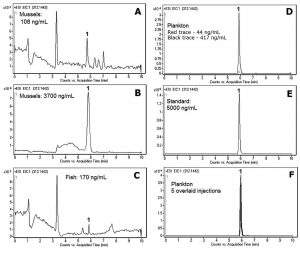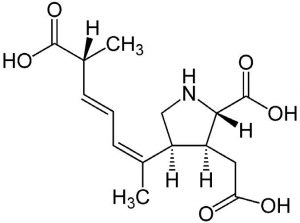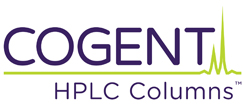Domoic Acid (DA) From Seafood Without Derivatization
Several Seafood and Plankton samples were tested for Domoic Acid (DA) which, as a highly polar compound, is poorly Retained on most Reversed Phase Columns. This developed Method based on HPLC and MS detection does not require derivatization of Domoic Acid.
The concentration of this potent toxin varied quite substantially between the samples (from 40ng / mL in Plankton to 3700ng / mL in Mussels). Despite different sample matrices, it was possible to detect and analyze Domoic Acid in a wide range of concentrations.
The results were very Repeatable (see 5 overlaid injections in Figure F). The detection limit depends on the instrument used. The Method can be used by regulatory agencies responsible for monitoring the occurrence of toxins such as the analysis of Domoic Acid in seafood samples.


Peak:
Domoic Acid 312.1442 m/z (M+H)+
Method Conditions
Column: Cogent Diamond Hydride™, 4μm, 100Å
Catalog No.: 70000-15P-2
Dimensions: 2.1 x 150mm
Mobile Phase:
—A: 50% MeOH / 50% DI Water / 0.1% Formic Acid
—B: Acetonitrile / 0.1% Formic Acid
Gradient:
| Time (minutes) | %B |
| 0 | 95 |
| 7 | 30 |
| 8 | 30 |
| 10 | 95 |
Post Time: 5 minutes
Injection vol.: 1µL
Flow rate: 0.4mL / minute
Detection: ESI – neg – Agilent 6210 MSD TOF Mass Spectrometer
Sample Preparation: Samples from Dr. R.Kudela, Univ. of California, Santa Cruz, Dept. of Marine Sciences. Samples were injected as received.
Attachment
No 140 Domoic Acid in Seafood Samples Analyzed by LCMS pdf 0.3 Mb Download File


